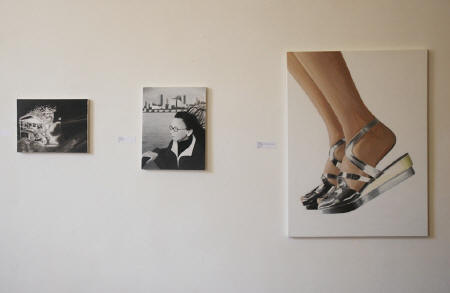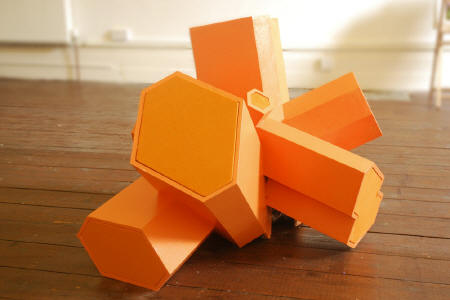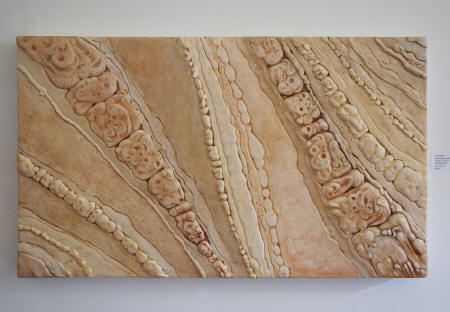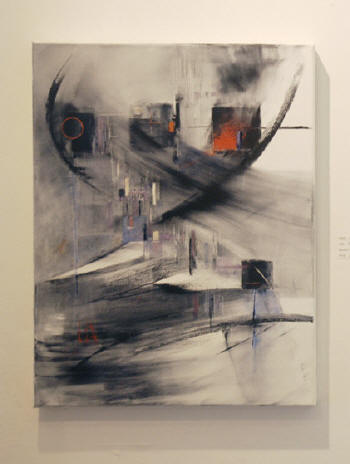|
|
| home | features | exhibitions | interviews | profiles | webprojects | gazetteer | links | archive | forum |
|
Artist’s Playtime: TAG at the Falmouth Poly Robin Mackay
TAG’s annual show of new work, ‘Artists at Play’ (Falmouth Poly, 16-27 September 2008) brings together four artists, the divergent form and content of whose work makes the show an experience that is in parts rewarding, even if as a whole troublingly inconsistent.
A larger canvas, an image of a woman’s lower legs and presumably expensive silver shoes, seems to resolve this embarrassment of riches in a way that, more than anything, recalls Jeff Koons’ celebrations of the erotic nature of hyperreal capitalist surfaces (specifically, the 2000 painting Niagara). Aziz presents the piece as a celebration of ‘the handmade life’, but if some problematisation of the glossy image is intended in this title (the painting itself as ‘handmade’?), the painting itself only revels in sheer opticality, and is none the worse for this. In the last few decades (and again, partly thanks to Jeff Koons and his erstwhile spouse) hardcore porn has become such common currency in contemporary art that it retains little immediate subversive power for those accustomed to the codes of the latter. Yet, apart from their welcome role in setting the more conservative browsers at the Poly ill at ease, Aziz’s series of magazine cutouts harbour the germ of an interesting idea. In the second panel, one full-colour hardcore image is presented within the silhouette of another, setting in motion a sort of visual pulsation – an erotic duck-rabbit – in which the hyperdetailed obscenity of the photographic image enters into exclusive alternation with the pure form of the silhouette: two forms of abstraction. Adding a welcome non-visual dimension to the show is Timothy Crowley’s intriguing sound-sculpture (picture below right). Presented as a kind of abstract crystalline structure of irregular columns exploding from the centre of the floor, it feasts greedily on nearby sounds, taking them back to its inner core to digest them and then spew them back, dissected and processed according to some unknown logic. It is hard to say whether
the piece would have been rendered more or less interesting were more
documentation provided on its inner mechanisms; but as it was,
throughout the evening its waves of commotion confronted the ambient hum
and
It certainly entertained those present (including small children, always a good indication with interactive works); its periodic spasms are a reminder of the strangeness of sound and of memory, as it serves both up in ominous shards, refracted through its crystalline digital surfaces. Sue Emery’s geological bas-reliefs (picture below left), made from materials whose provenance and method of working are at first glance pleasingly indiscernible, continue her exploration of the processes of folding, stratification and torsion that shape the planet. They thus tap in to a conceptual current (stemming from philosopher Gilles Deleuze and ultimately from Leibniz) for which ‘the fold’ is a key ontological figure, replacing a classical model of transcendent formation of inert matter, with a baroque dynamical process of ‘folds-within-folds to infinity’. But Emery’s pinkish-toned snaking forms also seem to operate a metaphorical transport between those hyperdense spaces in the depths of the earth and intestinal inner space, suggesting the biological torsion and compression of viscera or compressed spines, and thus telescoping natural processes and entities of different time-orders in a generalized geo-ontology that extends to our own natural history.
Even at their ‘prettiest’, however, they do not abandon themselves to the uninterrogated surface aestheticism that characterises Christine Allen’s mixed media canvases (picture below right). For those unprepared to make fine distinctions between these and any number of other similar works, Allen’s therapeutic powderpuff colours, archetypal geometries, heavily-worked surfaces, and vague titular references to ‘space’, ‘place’ and ‘memory’ can only come across as generic examples of the work of an army of incomers of a certain age who find comfort in treading water in the tourist-industry backwash of St Ives abstractionism. However eminently saleable, its inclusion in the show must strike anyone with an eye for what is intriguing in the other exhibitors’ work, as strange and somewhat cruel; a backhanded homage to a secondhand ‘tradition’ which ambitious new art in Cornwall must at all costs avoid.
The formation of a collective, so as to overcome the travails of the lone artist, is commendable, as is TAG’s enterprise in curating and presenting their own work through their own resources. But social and financial solidarity must not be mistaken for artistic affinity, and the problem with an artist collective set up with a view to mutual support, but without any selective criteria for participation, is that its members can end up merely clinging together for comfort. This makes it difficult to attain the degree of resolve, selection and definition that makes for stronger and more resolute artistic statements, the type of statements that would allow all involved to benefit from each other, and to move forward. Such stringency is particularly requisite in a town such as Falmouth which, unfortunately, continues to allow its artistic identity to be defined by annual degree shows. Their unthemed jumble is quite rightly excused by the nascent status of those involved. The somewhat apologetic stance taken by TAG cannot be so readily sanctioned. The title of the show indicates that the artists involved are ‘at play’, the works in progress and in process, and thus plead for a suspension of critical judgment. In fact, several of the exhibits in ‘Artists at Play’ make welcome moves beyond such ‘play’, and this is precisely what makes them worthy of consideration. But the participants’ reticence to draw out any critical conclusion about the direction and purpose of their individual and collective intentions means that individual strengths become attenuated by the confusion of the whole, which ends up being less than the sum of its parts.
|
|
|




